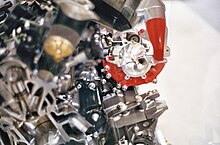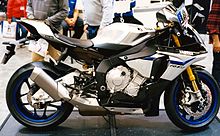9. KAWASAKI NINJA H2 R
OVERVIEW
The Kawasaki Ninja H2R hypersport motorcycle is an engineering marvel, made possible only through the sourcing of technological expertise from multiple divisions of Kawasaki Heavy Industries, Ltd. (KHI). The result of this unprecedented collaboration is a system of carefully crafted premium components that work in concert to create an unbelievably powerfulmachine—one that’s more than worthy of the legendary H2 name.
BIKE DETAILS
Kawasaki selected the literbike platform for its top-of-the-line Ninja H2 model, rather than continuing with the higher-displacement hyperbike Ninja ZX-14. Kevin Cameron explained that the liter-class is "the center of the high-performance market", attracting the best development in racing, with the best chassis and suspension design, so it made sense for Kawasaki to create a machine that could leverage this.
Engine and supercharger
The H2R engine is a 998 cc inline-4, four-valve, dual overhead cam design with a two-speed, centrifigual supercharger claimed by Kawasaki to develop 300 horsepower (220 kW). The supercharger is driven by a series of gears and shafts connecting the flywheel to a planetary drive, finally spinning a dog-shifted two-speed shaft attached to the impeller. Rider control is throttle by wire.
It is the first production motorcycle with a supercharger, although turbochargers were available on some models in the early 1980s.
A centrifugal supercharger has the advantage of generating less heat than other designs, especially scroll-type or screw-type superchargers. Excess heat in the intake charge can cause pre-ignition that will destroy the engine.
Electronic aids
Various observers said the Ninja H2R could be expected to have electronic rider aids including anti-lock braking system (ABS), traction control, engine braking control, and launch control.
Aerodynamics
The front fairing of the Ninja H2R features said to look like wings, made of carbon fiber like the rest of the bodywork. They may be aerodynamic devices designed to create a low-pressure zone to help move cooling air through the engine bay, or to produce downforce at high speed, or to provide straight-line stability in a short-wheelbase sportbike chassis.
Chassis
The H2 has a tubular, thin-wall steel trellis frame and a single-sided swingarm, with traditional sportbike wheelbase.
Explaining the advantages of the Kawasaki approach to exploiting aerodynamics instead of lengthening the wheelbase, a South African writer said "It's easy to build stability into a hard-accelerating drag machine with a long wheelbase...but Kawasaki wanted a track-day machine, one that would also go round corners."
High speed motorcycles often have long wheelbases: extra length is added by the extended swingarm on a typical dragbike; a typical land speed record streamliner has a meters-long wheelbase (3.7 meters for the current record holder, Ack Attack).
Street-legal Ninja H2
Specifications in the infobox are from Kawasaki unless noted. The street-legal Ninja H2 has been shown with rear-view mirrors in place of the track-only H2R's wings. The street-legal bike is said to make 200 horsepower (150 kW), probably with reduced supercharger boost compared to the H2R. The H2 and H2R share the supercharger (with a lower boost level on the H2) and many other components, with the exception of head gasket, cam profile and timing, and exhaust system. Cycle World has recorded a 1/4 mile time of 9.62 sec. @ 152.01 mph with a 0 to 60 mph acceleration at 2.6 seconds and a top speed of 183 mph.











